 By M.P. Pellicer | Stranger Than Fiction Stories Arlis Perry, 19, was murdered inside Stanford Memorial Church two weeks before Halloween, 1974. Her body was posed and mutilated in what appeared to be some type of ritual murder. Decades would pass before the identity of her killer would become known, however questions still lingered.  Bruce and Arlis Perry on their wedding day c.1974 Bruce and Arlis Perry on their wedding day c.1974 California, 1974 Arlis grew up in Bismarck, North Dakota and married her high school sweetheart Bruce D. Perry. Both of them attended the same high school and were popular students. Arlis was a cheerleader and Bruce, the son of Dr. Duncan Perry a dentist, had played sports. They both belonged to the Fellowship of Christian Athletes. During his year as a freshman in Stanford, Bruce corresponded with his fiancée, and he came back home to tie the knot and return with his bride to continue his studies. They had an apartment at Quinnel Hall, a residence on the campus for married students. Six weeks after leaving Bismarck, the one thing Arlis missed was her friends. Her husband was busy with his pre-med studies, and tutoring other students. This environment was totally different from her hometown in North Dakota, where she noted people were friendlier, however she was expanding her horizons when she secured a position as a receptionist at the law firm Spaeth, Blaise, Valentine and Kleinat two weeks before.  Arlis with friends from Bismarck c.1970s Arlis with friends from Bismarck c.1970s It was 11 p.m. on October 12 when Arlis decided to walk to the mailbox and drop off letters bound for Bismarck. Her husband accompanied her, and as they crossed by the church, which was about a 1/2 mile from their apartment, a minor argument escalated. Arlis told her husband she was going to visit the church, and she would join him later at the apartment. Bruce Perry did as his wife asked and walked back to their home. It was close to midnight when Arlis went inside, and there were two other persons inside praying. They left anticipating that the church would be closed at midnight. Arlis stayed inside, and later a passerby described where he saw a man in his twenties who was about to enter. He had sandy hair, parted on the left, medium build, wearing a blue short sleeved shirt and jeans. Steve Crawford the security guard, didn't get there until 10 minutes past midnight. He didn't see anyone inside, and locked up. The hours slipped by, and Bruce called the police at 3 a.m. when his wife hadn't come home. He had gone to the church around 12:15 a.m., but the doors were locked. He checked the side entrance, and they were locked as well. Later Stephen Crawford the security guard, who was a former Stanford police officer said he found her body just before 6 a.m. on October 13, in the east transept near the altar. He found the west side door forced open from the inside. Her hands were folded across her chest on top of her torn shirt, and her jeans had been folded across the legs in a diamond pattern. She was nude from the waist down, and her legs were spread apart. A 30-inch altar candle was shoved into her vagina, and another one was placed between her breasts. Arlis had been strangled and beaten, but what killed her was the ice pick plunged into the back of her head. The handle was missing since it was broken off. The final embellishment in this ritualistic tableau, was a large carved cross which loomed above her. Crawford told police that he checked the doors at 2 a.m., and they were locked. But there was no one to verify if this was true or not. A church official who viewed the scene called it "ritualistic and satanic". Later that afternoon, the non-denominational church was re-consecrated by Fathers John Duryea and Robert Giguere who celebrated a Roman Catholic mass, which began with a blessing scripted to reclaim the place from the forces of evil. 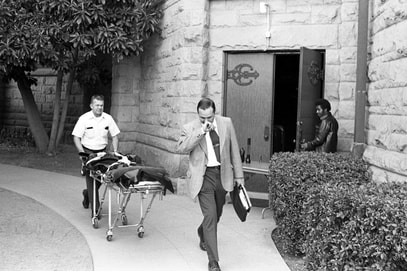 At the Arlis Perry crime scene c.1974 At the Arlis Perry crime scene c.1974 Initially the main suspects were Bruce Perry, Steve Crawford and an unknown sexual psychopath, possibly the one seen entering the church as it closed. The police withheld certain elements of the crime from the public and the press, including the fact the FBI in Washington DC lifted a perfect palm print from the candle inside of Arlis' vagina. Later it would prove not to belong to Crawford. On October 15 a service was held for Arlis, and in the meantime police continued the investigation. They interviewed Mark Connors who worked at the same law office as Arlis, and he related a strange story, which unfortunately the police did not pursue as closely as they should have. On the day before her death, Arlis was at the reception desk when a visitor arrived, who he assumed was her husband. She spoke to the young man for 15 minutes or so, in what he described as a "serious and intense" manner. He even thought she was angry at who he assumed was her spouse. He was a young man, husky and athletic looking, dressed in jeans and a plaid shirt. He was about 5'10", had curly, blondish hair and appeared clean cut. Mark Connors thought it was strange that Arlis didn't introduce him. He realized his mistake when he saw the real Bruce Perry at the church service. When questioned by police, Bruce Perry denied going to her job, and also thought it would be strange that his wife had not mentioned the visit. This was confirmed by her friends in Bismarck who were also eventually interviewed by police. The most glaring clue that was overlooked was the stranger who visited her job. He was similar in appearance to the young man seen entering the church just before it closed. Who knew Arlis enough to come to her job, since she had only been in the area a little over a month? Is it possible she knew him from somewhere else, even Bismarck? If one thing was certain was the premeditation aspect of the crime. The killer brought an ice pick with him, which is not usually what one carries to a house of worship. Later the police theorized the stranger who came to the office was a delivery man, but this seemed unusual that she would have a 15 minute conversation with an unknown person. Either she knew him, or he came on behalf of someone she did. 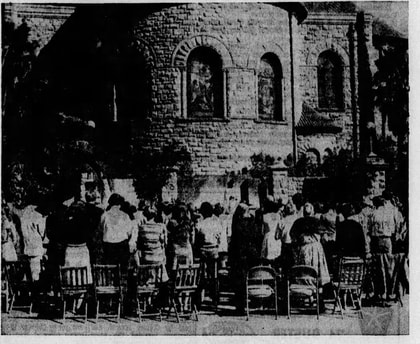 Sunday services were held outside the chruch due to Arlis Perry's murder c.1974 Sunday services were held outside the chruch due to Arlis Perry's murder c.1974 Arlis was interred on October 18 at Sunset Memorial Gardens in Bismarck. Most of those who attended the wedding were present for the funeral rites. Two weeks later on Halloween something strange happened. The temporary marker placed on her gravesite was stolen. No other marker in the cemetery was taken. The police found that a couple of "trophies" were taken from the murder scene. Could the marker have been another one? In the meantime, word reached Bruce Perry's parents in Bismarck. It seemed that Arlis and a friend, who they didn't know the name of, went to Mandan a neighboring town to convert members of a satanic cult to Christianity. This happened during the year when Bruce was away in California. Was this story true? The Santa Clara police did a cursory investigation and it turned out others had heard the story, but no one could provide specifics. Bruce Perry would go on to graduate and become a doctor, and the case became cold and then inactive. In 1979, a clue would surface. It was a passage found handwritten across a page, in a book about satanism which read "ARLIS PERRY HUNTED, STALKED AND SLAIN, FOLLOWED TO CALIFORNIA. STANFORD UNIV." In Maury Terry's book The Ultimate Evil he describes where Lt. Terry Gardner in Minot, South Dakota received a book titled The Anatomy of Witchcraft, which reached him via a middle person from David Berkowitz, who had been convicted of the Son of Sam crimes. Among other notes he highlighted in the book, there was a chapter called Evil on the Coast, where he underlined a sentence in a section about the Process which read: "Thou shalt kill. They say they are dedicated to bringing about the end of the world by murder, violence and chaos — but they, the chosen, will survive to build a new world of satanic glory." On the same page with a specially marked asterisk, and in brackets he indicated a section about the Chingons, which research shows was an offshoot of the Process Church based in California. He referenced other groups in the state tied to the occult. It wasn't until 1979, that Santa Clara County Sheriff's Department spoke to Berkowitz in Attica Prison for 30 minutes. He became agitated, and evaded answering the question if he had talked to the person who had killed Arlis Perry. He didn't answer either way. 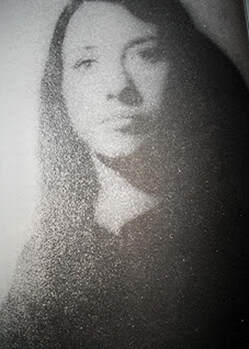 The only known picture of Mary Ann de Grimston who was believed to have been the true power behind the throne of The Process church The only known picture of Mary Ann de Grimston who was believed to have been the true power behind the throne of The Process church The Process Church of the Final Judgement was founded in 1963 by Robert (born Robert Moor in 1935) and Mary Ann (1931-2005, Maclean Moor De Grimston DePeyer) in England, after they split from the Church of Scientology. They reinvented themselves and adopted the surname of De Grimston. They fled from England and spent time in Mexico and the Bahamas. They came to the United States via Mexico in 1968. According to the church's charter "it was called by God to bring about the end of the earth and the final judgement of man." They predicted the world would end in 2000, and that Satan and Christ would be united. They also went by the name of The 4 Ps, and The Institute of Compulsions Analysis. In 1966, while in Mexico the couple with 22 followers lived in a roofless salt factory in Xtuul, where most of them were barefoot and dressing in rags. They lived without any utilities and ate beans. The only one reasonably dressed was Mary Ann de Grimston, who wore a bikini and a light sun coat. It was noted most of them came from very affluent backgrounds, one of them being Sabrina Verney, 19, daughter of Sir John Verney. Mary Ann de Grimston was originally charging a large amount of money for an introduction into the group. It was believed the mastermind of the group was Mary Ann de Grimston and not her husband Robert, who she ousted in 1974. In 1972, it was the believed the organization was either a cell or splinter group of the Church of Scientology. The Magical Mystery Museum in L.A. was a front for the group, and it was alleged six members of The Process, acted as the muscle for the Church of Scientology. A source told the FBI, The Process had its origin in Arizona State Prison. This was the time period when Arlis Perry was murdered at Stanford University. The goal of the Process was to set up chapters and coffee houses, in major American cities as a way to recruit members. A New York chapter was established in the late 1970s which is when David Berkowitz became a member, and he became associated with the individuals running what would become Best Friends Animal Sanctuary (BFAS). These persons were believed to have been involved in several murders that occurred in New York. In 1974, the name was changed to The Foundation Faith of the Millennium and they relocated to Arizona. By 1978, the Process were operating in Boston, Chicago, New Orleans, Miami, Houston and San Francisco. In 1980, the name was changed once more to The Foundation Faith of God. In 1993, The Foundation Faith of God changed its corporate name to Best Friends Animal Sanctuary (BFAS), and was organized "specifically as an institution devoted to the charitable and religious purpose for the prevention of cruelty to animals." That same year, BFAS purchased 3,000 acres in southern Utah, which was originally named Kanab Canyon, and was renamed to Angel Canyon by the BFAS. The goal was to take care of abandoned and abused animals. As of 2000, it was written they had solicited and received more than a million dollars a year from individuals and corporations. The inner circle of BFAS was the same since England.  Dr. Margaret T. Singer c.1980s Dr. Margaret T. Singer c.1980s The 1970s was a decade when there was good reason to worry about cults. The most infamous example was when Jim Jones killed hundreds of his followers in 1978. Another cult in Guyana was the House of Israel, led by a fugitive from the U.S. who called himself Rabbi Edward Emmanuel Washington or as "master, king or even god" by his followers. His real name was David Hill. When Jones' People's Temple poisoned their flock, Washington had thousands of members. In 1986, he was sentenced to 15 years in a jungle prison after pleading guilty to manslaughter. Dr. Robert P. Hopkins an instructor at Harvard Medical School wrote in 1978, that research showed cult members were "generally from Jewish or liberal backgrounds, none typically from Roman Catholics or Evangelical Protestant backgrounds." He wrote that according to research done by Dr. Harvey Cox, dean of the Harvard Divinity School, cult members he studied "were people who were withdrawn from problems in their own lives and in the world at large." These individuals wanted to retreat into a safer, simpler word provided by the cult environment. Dr. Margaret T. Singer (1921-2003), a psychiatric professor at the University of California in San Francisco wrote that cults have trouble recruiting lower class young people. "Lower class youth in the United States, primarily know there are no free dinners and no free meals. They can recognize a street hustle. Middle and upper class young adults, have not had enough experience with street hustlers in growing up to know how artful deceivers on the street can operate." Dr. Singer explained, "Cults supply their members with ready-made decisions about careers, sex and marriage, and the meaning of life. In return they demand total obedience, which they maintain through various programs of coercive persuasion." She offered group therapy for those fleeing cults, and found most of them were tired and undernourished, since they were forced to spend long hours on the street soliciting money for the cult. Dr. Singer testified as a brainwashing expert in the trial of Patty Hearst. She also played a role in the trial of Kenneth Bianchi, the Hillside Strangler and testified that he was faking symptoms of multiple personality disorder. She face harassment and death threats from groups that feared her exposing how most cults work. She was an outspoken critic of Scientology and traveled under an assumed name to avoid harassment. Dr. Singer's family and students were harassed as well. Her office was broken into and cult "operatives" would go through her trash and mail. They also picketed her lectures, hacked her computer and released live rats in her house. as well as leaving dead animals on her doorstep. 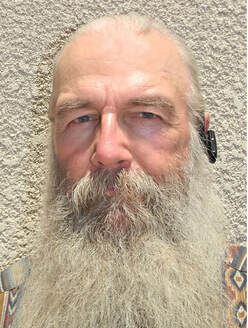 Brian McCracken c.2016 (Source - NYPost) Brian McCracken c.2016 (Source - NYPost) Whether cults were suspected in the murder of Arlis Perry is unknown, and despite having occurred on a major university campus, the case went cold, and the years slipped by. In 2016, a new witness came forward for the Perry case. His name was Brian McCracken, 64, and he told police that an entertainer living in New York was responsible for the crime. He recounted an unusual story of what happened inside the Stanford church on October 12, 1974. McCracken said he had left a coffee shop, and was walking past the church close to midnight. He heard "strange flute music" coming from inside, which was quite unusual considering what time of night it was. He went inside, and described the following as to what he saw: this guy up at the lectern, a young skinny white guy and he has an afro wig on, a light-colored large afro wig, looked very striking and he's playing a flute, a large silver flute. To the right of him on the altar was this nude girl lying on the altar. She has candlesticks burning, one on either side of her. As I walked down the aisle, he looked at me — he doesn't seem happy to see me, and then she is lying flat on the altar, and she is looking straight up to the top of the church. She turns her head to the left and smiles. By this time, I am within 20 feet of the flutist and her on the altar. 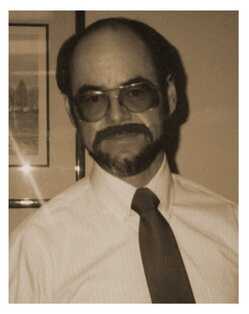 Stephen Blake Crawford (1946-2018) Stephen Blake Crawford (1946-2018) McCracken believed they were playing a "black mass" game which in the 1970s wasn't that far-fetched. He said the girl look comfortable and didn't appear to be afraid. The one who was getting the menacing looks was him. After leaving the church McCracken did not speak to police, not connecting the story in the newspapers he would read in the following days, and what he had seen. Within the next few hours when he witnessed the tableau, Arlis Perry was killed, and Stephen Crawford the security guard made the discovery of the posed corpse. Her panties were around her right foot. A prayer pillow stained with semen was found next to her. In 2011, McCracken was having a conversation with a retiring cop who was retelling the story of a cold case involving a murder committed in a church. This is when he thought of what he saw, and that it might be related to the cold case. He said he had seen the strange man at the altar in the Stanford marching band. He went on the internet and found a picture of the individual, and it matched the man he had seen. He gave a report to the Santa Clara County Police in December, 2011. The detective in charge of the Perry case, along with another police officer turned P.I. and a female psychologist interviewed the individual in February, 2012. The musician said he had thrown away the afro wig, which coincided with what McCracken had seen, and denied visiting the church. Soon after the interview the musician left California.  Maury Terry's book The Ultimate Evil posits that Arlis Perry's murder among others was carried out by a satanic cult that runs pornography, drug sales and a murder for hire ring Maury Terry's book The Ultimate Evil posits that Arlis Perry's murder among others was carried out by a satanic cult that runs pornography, drug sales and a murder for hire ring The case eventually went even colder, and it wasn't until DNA tests were done on the semen evidence that a definite link was made to Crawford, the campus security guard. On June 28, 2018 police came to his home in San Jose, California, 20 miles from the university with a search warrant. He locked the door to his bedroom and shot himself before the arrest. Later police found the torn-off cover of the book The Ultimate Evil among his belongings. After Arlis Perry's murder, police visited his apartment, but they didn't find any evidence of occult practices, however it was cluttered with what suspected to be stolen property. It wasn't until April, 1992 Crawford was arrested for taking rare and antique books from Stanford offices, which he had keys for. He even made himself an actual Stanford graduate by falsifying a blank diploma he stole. Coincidentally, he was a drum major and band president at Norte Dame High School in Sherman Oaks, class of 1964. 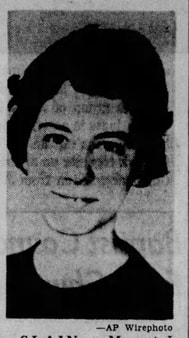 Margaret Williams an army chaplain's daughter was murdered by John Getreu in 1963 Margaret Williams an army chaplain's daughter was murdered by John Getreu in 1963 One important answer that died with Crawford, was whether he killed other people. It had been over 40 years since Arlis was murdered, did authorities believe that he was a participant but not the actual murderer? His death tied up a lot of loose ends, and perhaps it was thought prudent not to expose if there were others involved in the brutal murder so many years before. But this was not a far-fetched idea, since there was a dark undercurrent rippling through Stanford in those years when the murder of Arlis Perry took place. In May, 1970 a 19-year-old co-ed was the third woman to be robbed and raped at gunpoint, at the university within a 6 month period. She was leaving her job at the student union coffee house. Two victims later identified a man who gave his name as Charles Allen Matthews, 22. It's unknown what became of the charges, but he died in 1986. In 1973, Leslie Perlov's body was found in a clump of bushes on Stanford property. She'd been strangled with her scarf, and her skirt was pulled up around her waist. There was blood on her raincoat, and her pantyhose was stuffed in her mouth. Her case like Arlis' went cold, and not until 2018 was their a connection made via DNA.  John Arthur Getreu c.1963 and c.2021 John Arthur Getreu c.1963 and c.2021 Five months after Stephen Crawford killed himself in 2018, authorities arrested John Arthur Getreu, 74, for the murder of Leslie Perlov. A year later he was tied into the strangling of Janet Ann Taylor 21, who was killed in March, 1974 also at Stanford. Getreu was married and living in an apartment in Palo Alto, when he committed these crimes. In 1963, Getreu was 18 when he raped and strangled a 15-year-old named Margaret L. Williams, daughter of Lt. Col. Robert Williams who was the chaplain for the U.S. 8th Infantry Division. He was the son of Sgt. Charles Getreu who was stationed in Germany. Her body was found behind an American youth club, nude and savagely beaten. He was convicted and sentenced to 10 years. Getreu served six years and was paroled. He left Germany, moved to Reno, Nevada and married his first wife in 1970. He took up residence in Palo Alto from 1971 to 1975, which is when he killed Perlov and Taylor. In 1975 he pled guilty to statutory rape of a 17-year-old and served only one month of a six month sentence, and paid a $200 fine.  Arlis Perry as a cheerleader c.1970s Arlis Perry as a cheerleader c.1970s In 1978, his wife divorced him, and he married his second wife. A year later he moved to Newark, Ohio. A decade later he was back in California, tied to several different addresses. He also used the alias of Getrev and Gertrew. During the next few years, his second wife died, and he remarried. Ironically during 2007-2008 he served as exalted ruler of the Fremont Elks Lodge 2121 in Fremont, California. It was until 2018 that Getreu was tied into his crimes via DNA evidence. Getreu was a former employee of the Stanford Medical Center. He had been working as a security guard elsewhere at the time of the murders. He became a suspect in other cold cases. He died on September 22, 2023 while serving his sentence. On a side note there was a series of tunnels that ran from Stanford Chapel to Frenchman's Tower on Old Page Mill Road that date back to the 1880s. Could they have been used back in the 1970s? Also who did the palm print found on the candle, which was used to violate Arlis' body belong to? It wasn't Crawford since he was cleared back in 1974. Why did Arlis Perry insist on going to a mailbox at 11:30 p.m. on a Saturday night, when it would not be picked up till Monday? Officially this case is considered closed, but is it really? Sources - Tulare Advanced Register, San Francisco Examiner, The Journal Times
0 Comments
Your comment will be posted after it is approved.
Leave a Reply. |
Stranger Than Fiction StoriesM.P. PellicerAuthor, Narrator and Producer Archives
July 2024
Categories
All
|
Stories of the Supernatural
- Stories of the Supernatural
- Miami Ghost Chronicles
- M.P. Pellicer | Author
- Stranger Than Fiction Stories
- Eerie News
- Supernatural Storytime
-
Astrology Today
- Tarot
- Horoscope
- Zodiac
-
Haunted Places
- Animal Hauntings
- Belleview Biltmore Hotel
- Bobby Mackey's Honky Tonk
- Brookdale Lodge
- Chacachacare Island
- Coral Castle
- Drayton Hall Plantation
- Jonathan Dickinson State Park
- Kreischer Mansion
- Miami Biltmore Hotel
- Miami Forgotten Properties
- Myrtles Plantation
- Pinewood Cemetery
- Rolling Hills Asylum
- St. Ann's Retreat
- Stranahan Cromartie House
- The Devil Tree
- Trans-Allegheny Lunatic Asylum
- West Virginia Penitentiary
- Paranormal Podcasts
"When misguided public opinion honors what is despicable and despises what is honorable, punishes virtue and rewards vice, encourages what is harmful and discourages what is useful, applauds falsehood and smothers truth under indifference or insult, a nation turns its back on progress and can be restored only by the terrible lessons of catastrophe."
- Frederic Bastiat
- Frederic Bastiat

Copyright © 2009-2024 Eleventh Hour LLC. All Rights Reserved ®
DISCLAIMER
DISCLAIMER
 RSS Feed
RSS Feed
















